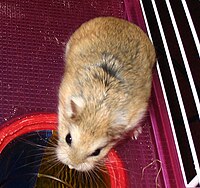Difference between revisions of "AY Honors/Small Mammal Pets/Answer Key"
(+picture) |
|||
| (One intermediate revision by the same user not shown) | |||
| Line 1: | Line 1: | ||
| − | {{ | + | {{Taxobox_begin | color = pink | name = Roborovski Hamster}} |
| − | {{ | + | {{Taxobox_begin_placement | color = pink}} |
| − | + | {{Taxobox_regnum_entry | taxon = [[Animal]]ia}} | |
| − | + | {{Taxobox_phylum_entry | taxon = [[Chordata]]}} | |
| − | {{ | + | {{Taxobox_classis_entry | taxon = [[Mammal]]ia}} |
| − | {{ | + | {{Taxobox_ordo_entry | taxon = [[Rodent]]ia}} |
| − | {{ | + | {{Taxobox_familia_entry | taxon = [[Cricetidae]]}} |
| − | + | {{Taxobox_subfamilia_entry | taxon = [[Cricetinae]]}} | |
| − | {{ | + | {{Taxobox genus entry | taxon = ''[[Phodopus]]''}} |
| − | {{ | + | {{Taxobox_species_entry | taxon = '''''P. roborovski'''''}} |
| − | + | {{Taxobox_end_placement}} | |
| − | + | {{Taxobox_section_binomial_parens | color = pink | binomial_name = Phodopus roborovski | author = [[K. A Satunin|Satunin]] | date = 1903}} | |
| − | {{ | + | {{Taxobox_end}} |
| − | {{Taxobox genus entry | taxon = ''[[ | ||
| − | {{ | ||
| − | {{ | ||
| − | {{ | ||
| − | {{ | ||
| − | |||
| + | [[Image:Roborovski hamster.jpg|left|200px]] | ||
| + | '''Roborovskis''' ('''''Phodopus roborovski''''') are the smallest of the [[hamster]]s commonly kept as [[pet]]s; they are also the fastest. On average, they live the longest of any pet hamsters, living about three to three and one-half years of age. | ||
| − | + | They are easily startled and are generally quite shy but curious. They're social and usually sleep together in one place. They aren't good pets for families with children. They are the worlds fastest hamsters. They're obviously also not a good fit for someone who wants a hamster that they can cuddle. Roborovski's are certainly not cuddlers. They are generally the size of a thumb and can easily squeeze through the bar of the cage, so careful consideration of cage choice is important. Because of their size and speed, Roborovski's are best for people who prefer to observe rather than to play with their pet. | |
| − | |||
| − | + | ==External links== | |
| − | + | [http://www.petwebsite.com/hamsters/images/roborovski.jpg Image of a roborovski] | |
| − | + | [[fr:Hamster de Roborovski]] | |
| − | + | [[ja:ロボロフスキーハムスター]] | |
| − | + | [[pl:Chomik Roborowskiego]] | |
| − | |||
| − | |||
| − | |||
| − | == | ||
| − | |||
| − | |||
| − | |||
| − | |||
| − | |||
| − | |||
| − | |||
| − | |||
| − | |||
| − | |||
| − | |||
| − | [[ | ||
[[Category:Hamsters]] | [[Category:Hamsters]] | ||
| − | |||
| − | |||
| − | |||
| − | |||
| − | |||
| − | |||
| − | |||
| − | |||
Revision as of 16:48, 11 December 2005
Template:Taxobox begin Template:Taxobox begin placement Template:Taxobox regnum entry Template:Taxobox phylum entry Template:Taxobox classis entry Template:Taxobox ordo entry Template:Taxobox familia entry Template:Taxobox subfamilia entry Template:Taxobox genus entry Template:Taxobox species entry Template:Taxobox end placement Template:Taxobox section binomial parens Template:Taxobox end
Roborovskis (Phodopus roborovski) are the smallest of the hamsters commonly kept as pets; they are also the fastest. On average, they live the longest of any pet hamsters, living about three to three and one-half years of age.
They are easily startled and are generally quite shy but curious. They're social and usually sleep together in one place. They aren't good pets for families with children. They are the worlds fastest hamsters. They're obviously also not a good fit for someone who wants a hamster that they can cuddle. Roborovski's are certainly not cuddlers. They are generally the size of a thumb and can easily squeeze through the bar of the cage, so careful consideration of cage choice is important. Because of their size and speed, Roborovski's are best for people who prefer to observe rather than to play with their pet.
External links
Image of a roborovski fr:Hamster de Roborovski ja:ロボロフスキーハムスター pl:Chomik Roborowskiego

